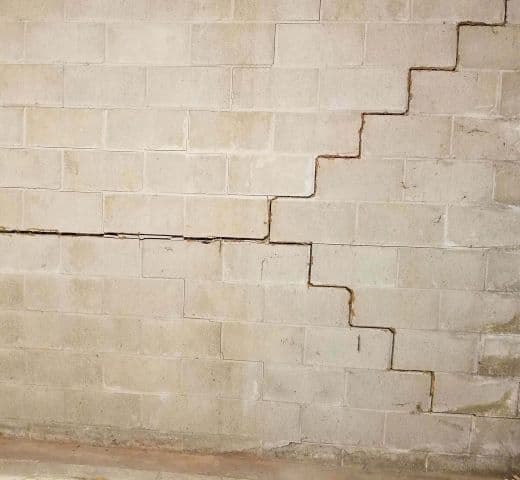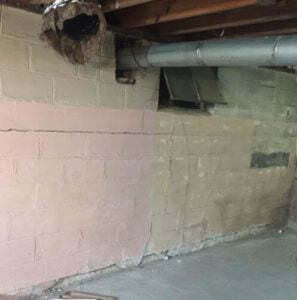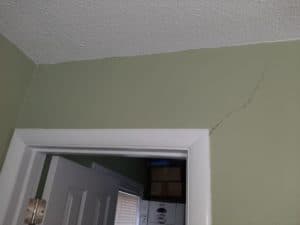
Originally posted 8/20/18, revised 11/12/20
If your home has a crack in the foundation, you probably want to know three things: what caused it, how significant it is, and what it will cost to fix.
Acculevel has been repairing foundations since our start in 1996. Founded by Andy Beery, we’re a family-owned and operated company that believes in honest and transparent business practices. We’ve repaired foundations and restored peace of mind to tens of thousands of homeowners across our service area, and we want to address your questions clearly and concisely.
In this article, we’re going to look at the circumstances that lead to foundation cracks, what these cracks tell us about your home’s health and stability, and what repair methods and costs are. We’ll also provide you with additional resources and information, so when you hire a contractor to make repairs, you can be confident in your decision.
There are two likely culprits: hydrostatic pressure and settling.
Hydrostatic pressure is the term used to describe water pushing against your foundation. When it rains, water accumulates in the soil until the ground is fully saturated. If it rains after the saturation point is reached, there’s nowhere for the water to go. Your foundation is then required to function like a dam, to keep the water out of your basement or crawl space.
If too much water accumulates, your foundation will crack. The cracks created by hydrostatic pressure often begin as thin hairline cracks. But as the pressure increases, the cracks widen and allow water to intrude into the house.
 This photo was taken by an Acculevel project manager during a routine estimate appointment. Hydrostatic pressure has pushed the wall until it has cracked across the center and is now bowing inwards.
This photo was taken by an Acculevel project manager during a routine estimate appointment. Hydrostatic pressure has pushed the wall until it has cracked across the center and is now bowing inwards.
Wider cracks can lead to bowing or leaning foundation walls, and this is where major trouble begins. If you have a foundation wall that has cracked across the center, or has a stair-step crack growing in between blocks, you need to get it repaired at once. Left alone, a bowing wall will worsen until the wall starts to fail and eventually collapse.
Your home’s foundation settles over time; this is a normal and expected process. Your house adds significant weight to a section of ground, so the ground shifts as it accommodates the added mass.
It’s like what happens when you set up a collapsible canvas chair along the sideline, so you can watch your kid’s soccer game. The ground on a sports field is pretty consistent; when you sit down in the chair, all four legs sink in equally. But if you set up that chair on a river bank to watch the Independence Day fireworks, that may go very differently. You could find yourself wobbling badly, if one leg is settling into softer soil.
 This photo was taken by an Acculevel project manager during a routine estimate appointment. It shows a crack in the drywall, which is a sign of settling. The door is also hard to close.
This photo was taken by an Acculevel project manager during a routine estimate appointment. It shows a crack in the drywall, which is a sign of settling. The door is also hard to close.
The same problem can occur with a house. If the soil composition is not consistent across the property, or water erodes the ground underneath one section, your foundation will settle unevenly.
When a foundation settles unevenly, it creates a strain on the home’s overall structure. This is because the building components of your home- concrete, treated lumber, brick, tile, drywall- are not flexible. They’re meant to hold their form and keep your house stable. So an uneven foundation creates tension in the building that can eventually crack.
There are three major symptoms of a settling foundation:
As you might expect, the ideal repair type varies depending on the type of crack you have in your foundation. We give a brief explanation for each of these methods, but include links to articles that provide a more in-depth explanation.
If your foundation is showing thin hairline cracks on the inside and you have these repaired promptly, an epoxy fill is usually the only repair that’s required. This is relatively easy and inexpensive. Now, if the cracks go all the way through the foundation or are letting in water, you’ll need interior and exterior repairs (both are covered in the linked article).
Please keep in mind that if water seeps into your basement or crawl space where there are no cracks, or new cracks keep appearing, you should invest in waterproofing. Hydrostatic pressure is clearly an ongoing problem and relieving the pressure is the best way for you to protect your home.
If your foundation has the more ominous horizontal or stair-step cracks, you need to fix this as soon as possible, as these can be signs a floor will collapse if the damage worsens. The repair methods vary, depending on how significant the damage is. If the wall is bowing 2 inches or less, carbon fiber straps are your best bet. If it’s bowing inward more than 2 inches? You need wall anchors or helical tiebacks.
 This photo was taken by an Acculevel project manager during a routine estimate appointment. The basement wall has both horizontal and stair-step cracks.
This photo was taken by an Acculevel project manager during a routine estimate appointment. The basement wall has both horizontal and stair-step cracks.
Unlike foundation cracks caused by hydrostatic pressure, settling only has one repair method: piers. Many contractors install push piers, but after installing both push and helical piers, Acculevel firmly believes that helical piers are the best choice for residential building repairs.
Already familiar with piers? We explain why we feel so strongly about helical piers.
I encourage you to reference our free comprehensive guide to foundation repairs. It can be read in its entirety, you can select the chapter relevant to you, or bookmark it as a reference when you meet with contractors.
If you have a major settling issue or a bowing wall, you may be ready to have a contractor come to your house now, and read the guide later.
Please make sure you verify that any company you choose is reputable, insured, and accredited by the Better Business Bureau. Not sure what questions to ask, or what information you should acquire about the company you hire? Please use our guide to questions you should ask a contractor, with a free downloadable form.
If you live in Indiana or the surrounding states, contact Acculevel. We are a family-owned and operated company, and we provide free written estimates. One of our experienced project managers will evaluate your bowing wall, then recommend the best course of action for you. Our goal is to help you keep your home strong and healthy for years to come.